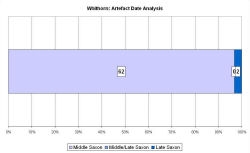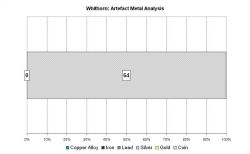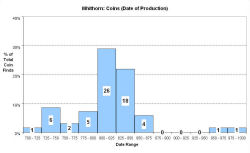Fingerprint charts for i) artefact date analysis, ii) artefact type analysis, iii) artefact metal analysis and iv) coins – date of production




Reference: Hill 1997
Archives:
http://ads.ahds.ac.uk/catalogue/search/fr.cfm?rcn=RCAHMS06-63298
Bede records that Ninian was appointed bishop to a Late Roman Christian community in Whithorn in the 5th century, and it is generally believed that Ninian introduced a monastic community modelled on western European lines. The modern parish church and medieval priory occupy a slight hill west of the medieval town of Whithorn. Excavations in the Glebe Field to the west of the priory from 1972-84 and 1986-91 have revealed development of the site from c. AD 500.
By the mid-6th century the east end of the hill was organised into an inner precinct of graves and 'shrines', and an outer residential area. A large assemblage of finds indicates widespread trading contacts and sophisticated artisan craft activity. There are strong Irish characteristics in the early phases but by the early 8th century there were timber-framed buildings comparable with those from Hartlepool. From c. AD 730-845 Whithorn was a Northumbrian minster, including a range of ecclesiastical buildings and possible guest quarters to the south. Associated finds include a large group of Northumbrian coins. Debris scattered across unoccupied ground between the monastic buildings contained other diagnostic Anglo-Saxon finds, including strap-ends and dress pins. The VASLE dataset is derived from the EMC only but they reflect a Northumbrian monastic settlement that fits into the Northumbrian pattern for coin loss, making Whithorn the only known 'productive site' in Scotland. The lack of evidence for continued Irish links suggests that Whithorn now looked entirely to the east for its trading contacts. The period ends with the burning of the site, as a result of the political turmoil in the mid-9th century.
However, it appears that monastic life was restored after the fire and from c. AD 845-1000/1050 some ecclesiastical buildings were restored and settlement continued throughout this undocumented period. The site provides the context for the sculptured crosses of the Whithorn School. These indicate a resurgence of British culture and suggest that the local British population had reasserted their identity, although there was also a strong Scandinavian partnership (Hill 1997, 54). The finds include a handful of 10th-century objects of Scandinavian type, including an ornamented weight and a fragment of hack silver. Specifically Irish finds are sparse until the end of the period. The largest body of material is the waste from the manufacture of antler combs from the mid-9th century onwards, marking the development of urban industry and of the monastic town.
Fingerprint charts for i) artefact date analysis, ii) artefact type analysis, iii) artefact metal analysis and iv) coins – date of production




© Internet Archaeology/Author(s)
URL: http://intarch.ac.uk/journal/issue25/2/4.4.66.html
Last updated: Tues Apr 21 2009